All about gasoline snow blowers
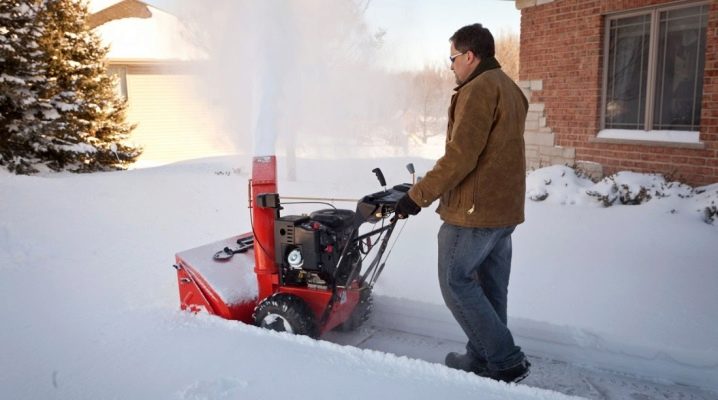
Removing snow is not an easy task, and in fact, in the overwhelming majority of regions of our country, winter lasts several months a year and is characterized by heavy snowfalls. In winter, the fight against snow turns into a global problem, to solve which a huge amount of effort is rushed. In most cases, a person simply cannot cope without the help of special equipment. Large snow blowers at first solved problems for utilities, road workers and large enterprises, but now light household models are already being produced that any summer resident can afford. At the same time, a significant segment of the market is occupied by electric models, while gasoline units are often forgotten, and undeservedly.
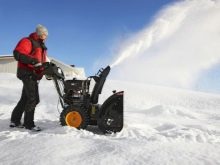
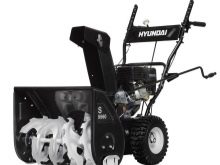
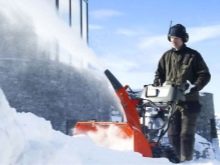
Peculiarities
Serious snowblowers driving through winter streets and snowy highways are mostly gas powered because they are based on the vehicle's design, but don't think that all miniature snowblowers are necessarily powered by an electric battery. Even household models can be gasoline powered by a small internal combustion engine, and this design can have both advantages and disadvantages.
The first obvious advantage of a gasoline engine over an electric one is power. - it directly affects productivity, therefore a relatively small gasoline snow blower is able to clear snow from even a large area in the shortest possible time.
In addition, most gasoline-powered units do not just remove snow, but also have the ability to run independently - they can only be guided without pushing. And in the absence of such a function, the price drops significantly and the unit becomes quite affordable.
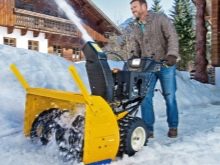
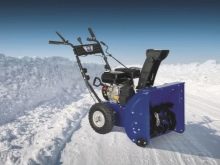
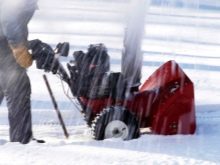
A liquid-fueled snow blower grinds snow much more efficiently and is able to throw it up to a distance of 10-12 meters, which is very convenient if you need to clear not a narrow path, but a wide road. At the same time, more expensive models are often equipped not with wheels, but with caterpillars - this is hardly useful on a personal plot, but it will be very useful for cleaning a skating rink or on a hillside. Needless to say, a gasoline snow blower does not have the slightest connection to an outlet, and its use is possible absolutely in any conditions, including far from civilization - provided that there are enough gasoline reserves.
However, it is impossible not to note some of the shortcomings that force a certain circle of consumers to make a choice in favor of electrical engineering. A truly powerful gasoline-powered unit will weigh quite a lot, and the tracked version is also huge in size, so it is quite problematic to transport or use the non-self-propelled version in some situations. Prices for equipment with a gasoline engine are also much higher than for cars with electric traction. Finally, any gasoline engine is always inferior to an electric one in terms of noise and gaseous emissions, therefore, in a small area near the house, many may consider the use of such technology an inappropriate solution.
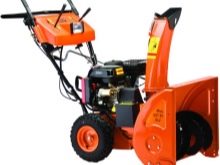

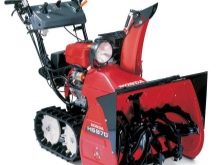
Device
As befits a commonly used unit, a snow blower is a fairly simple mechanism, but still allows it to remove snow very effectively in any conditions. Consider the main components that make up such a machine in order to understand the general principles of its operation.
The gasoline engine is the heart of the mechanism, thanks to which it is able to carry out the tasks assigned to it. Snow blowers can be based on a two- or four-stroke engine, but in any case, it drives the auger, that is, a special knife, thanks to which the dense structure of the snow is crushed. The auger itself is located, as it were, inside the front bucket, which, in turn, allows you to collect the main part of the snow cover from the cleared area without forming dumps on the sides of the cleared area. The snow, taken by the bucket and crushed with the help of the auger, falls into a chute, that is, a special elongated pipe, set aside somewhat to the side for throwing the crushed snow masses far beyond the clearing site. The entire structure is mounted on wheels or tracks, allowing the unit to move. All control of the mechanism is concentrated on the handles, which are held in the hands of the operator.
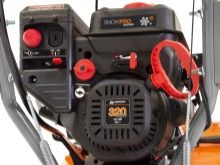

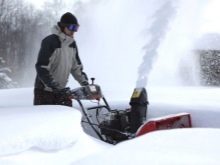
Above, the simplest version of the snowplow is described - of those that are massively used in everyday life, for example, in personal plots. In practice, a snow blower can be much more complex, especially if it is an expensive model for clearing large areas faster.
What are they?
A gasoline snow blower, it would seem, is not such a diverse unit as to classify it especially, and yet experts distinguish many varieties of such mechanisms, focusing on one or another indicator. All of them can be considered endlessly, therefore, we will consider only the main classification criteria - those that immediately catch the eye.
- The ability to move independently. A built-in gasoline engine could move the unit forward, but that was not the case - in pursuit of cheaper prices, some manufacturers produce extremely simple models with a single-stage gearbox, which literally have to be pushed in front of you. Often, such hand-held mini-samples of equipment are rather modest in size, which, of course, affects performance. The self-propelled unit is usually not so small anymore - its engine is definitely larger, with a capacity of 8 liters or more. with., but in the most serious copies, the unit is even able to take away its operator.


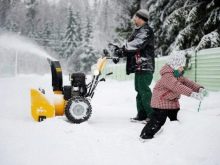
- Household or professional. You can even classify snow blowers into these two categories by eye - by size. But in the case of relatively small models, this is often done by evaluating the chassis. A professional unit is designed to cope with the most serious snow drifts and it is completely unacceptable for such a technique to get bogged down in the snow, therefore it is often made crawler, which turns it into an all-terrain vehicle in winter performance. For domestic needs, such units are not produced - their capacity is always excessive, and the cost is not affordable for ordinary people.
Wheeled solutions cannot be called unequivocally domestic, since the same street snowblowers are often an ordinary car on wheels, but in catastrophic situations only professional equipment on tracks is used.
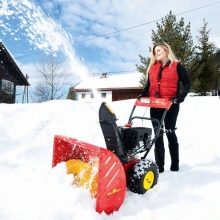
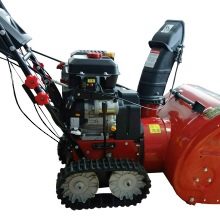

- Performance. This indicator indicates what area the unit is able to remove and in what time, and one of the determining factors here will be the width of the bucket. Obviously, a bucket width of up to a meter may be enough for cleaning the yard - even to clear a car exit, you need to walk along the road only 2-3 times.When it comes to clearing a large track or a large area with a significant width, not only the width of the bucket is important, but also a powerful snow thrower capable of throwing snow far beyond the cleared area.

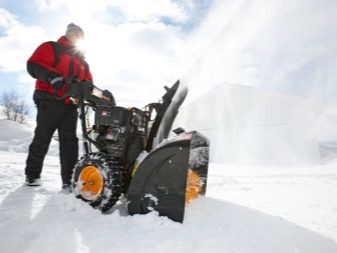
- Functionality. The simplest unit for the yard, most likely, just makes a path, not allowing pedestrians or cars to drown in the snow - it removes the main layer of snow, not pursuing the goal of removing the slightest snow dust. A multifunctional unit with a brush or other special equipment can be used in special cases when special care of the area is required.
So, in the case of rink cleaning, it is supposed to clean the surface to ice while maintaining its flat surface, and on the streets of cities, on the contrary, the goal is to fight ice due to sprinkling with reagents.
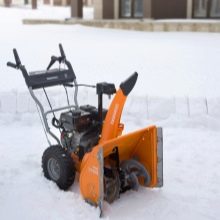
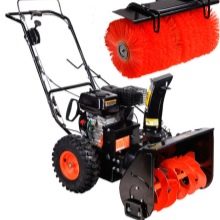
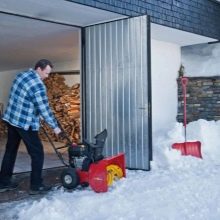
Rating of the best models
Compilation of any rating is always fraught with bias, in addition, each hit parade tends to become outdated rather quickly. To prevent this from happening with our rating, we will not distribute seats or hang any unambiguous labels, but immediately make a reservation that the presented models are only one of the best and most in demand right now.
At the same time, a more suitable and practical model may be found to solve the problems of each specific reader, but we only give a general idea of the possible options.
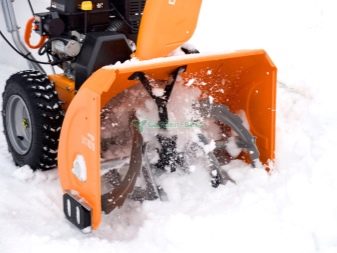
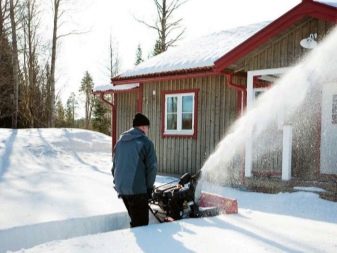
By reliability
The reliable category includes those snow blowers that have shown themselves to be durable and able to cope with tasks of any complexity. The cost of the presented models may shock an inexperienced buyer, but you have to pay for good quality.
- Husqvarna ST 5524 with a cost of around 100 thousand rubles, it surprises with its compactness. The self-propelled unit is "shod" in tires with deep tread and saves fuel well, and for work in the dark, the design has headlights.
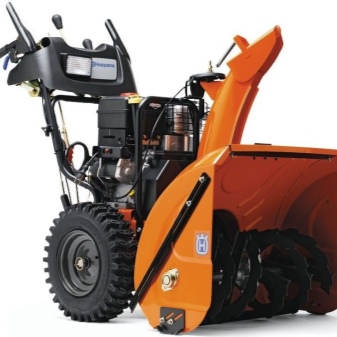
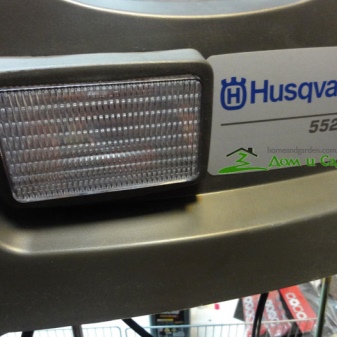
- Wolf-Garten SF 66TE it is considered to be almost the most common in our country - at a certain time it was widely used by private homeowners, utilities, and large enterprises. With a snow throw of 8-10 m, this machine is good for clearing open spaces. Although it captures a strip only 60 cm wide, it buries itself in snowdrifts up to half a meter high. The price starts at 120 thousand rubles.
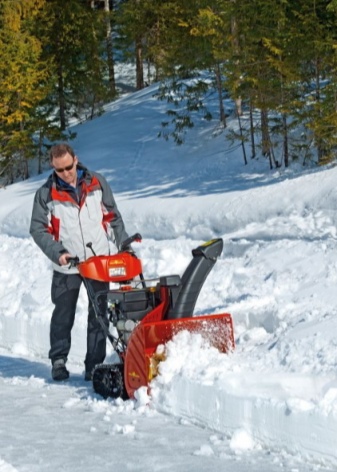

- Daewoo DAST 1080 - the only Chinese unit in our review that got here due to its high performance - its bucket immediately captures 72 cm in width. The significant quality, despite the dubious region of origin, is indicated by a rather high price for China, starting from the same 120 thousand rubles.

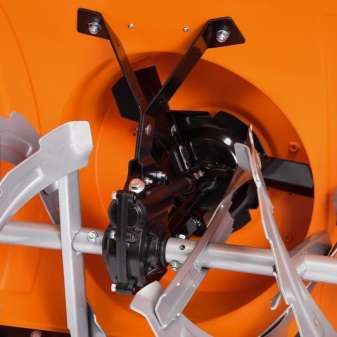
Cheap
The low cost of technology for a significant number of consumers is one of the main selection criteria. The brand in this case is no longer so important - in principle, only that the owner of the backyard can afford such a unit.
- Kawashima KCM24-F Is one of the most popular "home" snow blowers in Russia. Compared to other similar models, this car costs a penny - you can find it for about 40 thousand rubles.
- DENZEL GSB-53 - an alternative device from the same price category, characterized by small dimensions and fuel economy with high-quality snow removal and minimal noise. What the manufacturer saved on was on the headlight - in the evening you won't work with this unit in the snowdrifts.
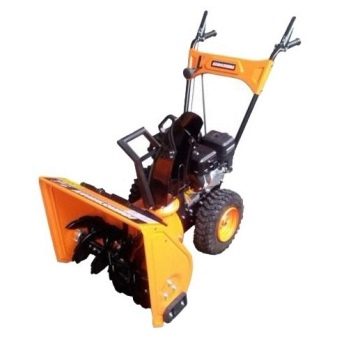

- RedVerg RD24065 - just a sample of a budget snow blower, which, if you really want to, can be purchased even for 30 thousand rubles. Contrary to popular fears widespread about cheap products, this unit successfully performs minimal functions - it throws snow far away and overcomes ice, and even pleases with the build quality.
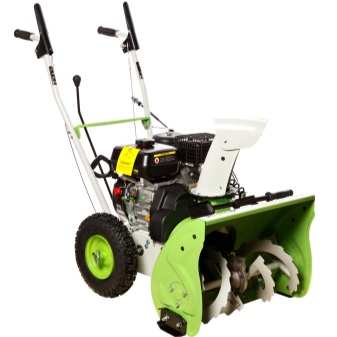
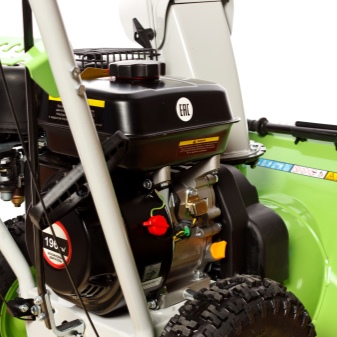
Lungs
Light weight is another fundamental characteristic for snow blowers, since this indicator determines how easily they can be moved by human efforts, without turning on the built-in engine. For home use, lightweight models are usually welcome.
- GSTSS 163 cm - is far from the lightest snow blower, since its weight is as much as 60 kg, but for a self-propelled unit this is still a very modest figure.By the way, the indication of centimeters in the name of the model should not be surprising - these figures indicate the volume of the engine, and not at all the width of the bucket (56 cm), as one might think.
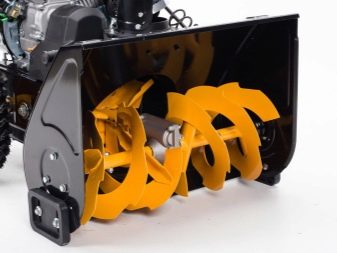
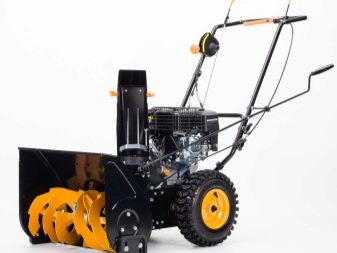
- Home Garden PHG 61 - another compact model, already a little lighter - weighing 57 kg. With not the smallest weight, the device still pretends to be called a baby, because most of its parameters are quite modest - the power is only 5.5 liters. with., but maneuverability is quite high for cleaning difficult landscapes.
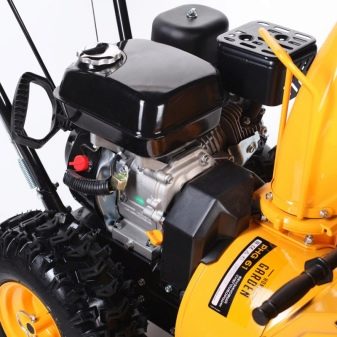
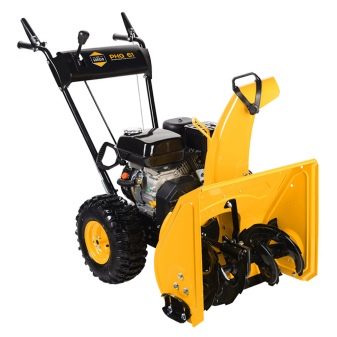
- Intertool SN-4000 with its weight of 45 kg, it claims to be one of the lightest among the gasoline counterparts, while its capabilities turn out to be quite modest, since the engine produces no more than 1.7 kW of power. At the same time, he is quite capable of clearing a path 46 cm wide for convenient walking around the yard.
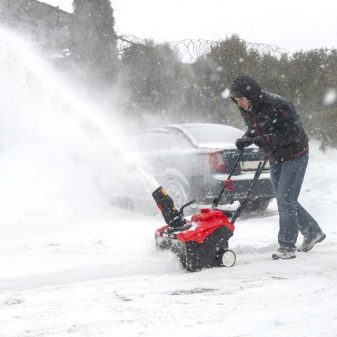
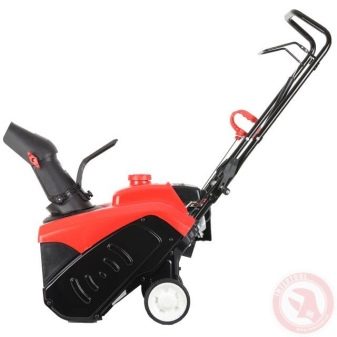
How to choose?
The correct choice of a household or industrial snow blower is impossible without a clear understanding of the tasks assigned to it, as well as the characteristics of the territory in which it will work.
So, for home use in an area that does not exceed 100 square meters. meters, a non-self-propelled compact wheeled device is usually enough, which is inexpensive, but will fully cope with snow removal. You can store such a mechanism even inside the house, and with the timely cleaning of fresh snow, clearing paths and adjoining parking will not seem like a big problem.
Expensive and high-quality equipment, especially on tracks, is chosen only for clearing large areas and significant amounts of snow. A unit capable of coping with such a task quickly cannot be light by definition, so you will have to spend money on an expensive self-propelled option. If difficult conditions caused by snow are not uncommon on the site, it is worth paying attention to the presence of several speeds of work (an important indicator for cleaning uneven snow cover, which is typical with irregular cleaning). For rough terrain, choose a model with a high level of maneuverability.
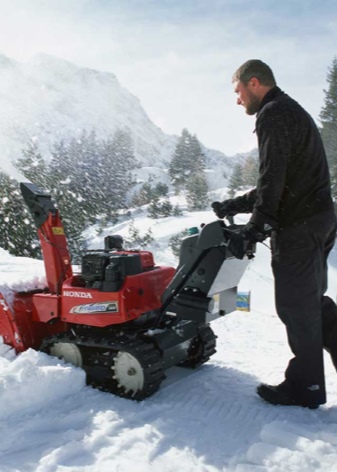
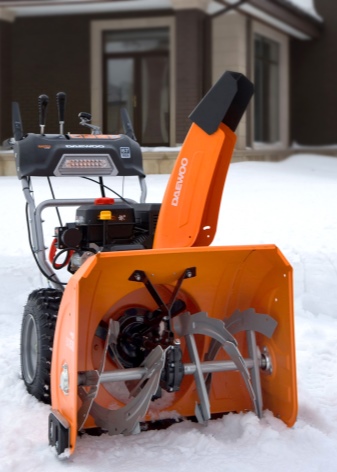
In order to prevent the formation of snowdrifts from previously removed snow along the cleared path, consumers often pay attention to the range of discharge of the snow mass, but experts point out that this indicator is not of fundamental importance. Crushed snow can be quite light, and if cleaning is also carried out in windy weather, then the real indicator can be very different from that indicated in the technical documentation in any direction.
If the choice between a wheeled and tracked model does not seem obvious, think about the specifics of the area to be cleaned. For an area with slopes, the tracked model is indispensable, it is also more practical when removing large-scale snowdrifts and more easily overcomes curbs. But, of course, there were some drawbacks. For example, due to the lack of wheels, it is difficult to push the unit even for a short distance, so it will either move strictly on its own course, or you will pay with enormous efforts for each meter.

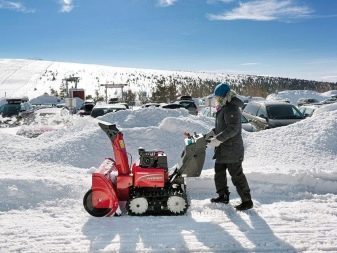
In a sense, it is worth paying attention to the manufacturer as well. Well-promoted brands offer equipment somewhat more expensive than the average price, but you can be sure of its quality and durability, and service centers are always somewhere nearby. In addition, you can purchase new spare parts instead of the broken ones in any major city. At the same time, there are industry leaders both among premium vehicles (the American company Husqvarna and the Japanese Honda) and in the middle segments (MTD, Wolf Garten, Craftsman) and economy class (Champion and Patriot).
Finally, not every consumer understands what is expensive and what is cheap in this area. Unfortunately, absolutely cheap models of snow blowers do not exist - their minimum price on average starts from 20 thousand rubles, and all units costing up to 50 thousand rubles are considered budgetary.The middle class includes more powerful models with increased performance and slightly expanded functionality, their price can go up to 120 thousand rubles.
If the question is not about the cost, but about the maximum return on the purchase over the years, be prepared for the fact that the unit can cost up to half a million rubles.
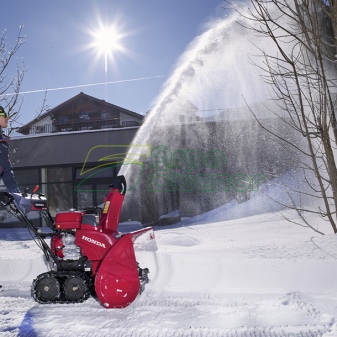

Instructions for use
Each model of a snow blower must be supplied with instructions for use, taking into account the characteristics of a particular piece of equipment, but there are general rules that should be followed. For example, we must not forget that a snowplow is a rather dangerous machine, because a rotating auger, although it never gains great speed, is capable of catching clothes or even a person's limb, and it will be problematic to escape from its captivity without help. If this is not done immediately, the likelihood of serious injury increases significantly, because the unit has significant strength. In this case, a self-propelled model, left unattended in operation, will continue to move in a straight line, which can also lead to misfortune.
Use of the machine as a whole must be performed with great care. Suffice it to recall that the gasoline with which the snow blower is refueled tends to easily ignite and even explode, therefore it is unacceptable to refuel near open sources of fire and with the engine running. Even a jet of snow being thrown can pose another hazard - its strength may be sufficient to break a window or severely damage your eyesight if it hits your eyes directly from a short distance.

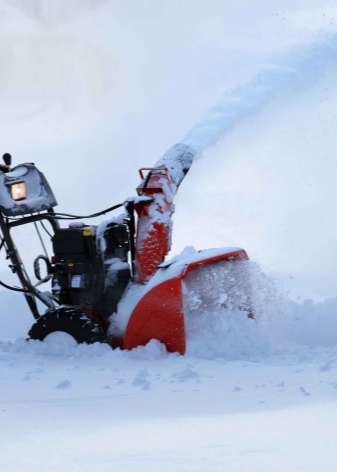
Even if you do not take into account the above hazards, you still need to carefully monitor compliance with all the rules common to all equipment. So, before starting the first operation, you should definitely study the instructions so that careless handling does not contribute to the premature failure of the mechanism. Self-repair of the unit is almost always discouraged by manufacturers, and in the included form it is strictly prohibited.
In addition, when servicing a snow blower based on a gasoline engine, all fuel must be drained first, and work should be performed only in a dry and insulated room.

Owner reviews
Having studied the comments of the happy owners of such equipment on various forums on the Internet, we come to the conclusion that most of them are satisfied with the money spent. Even small and compact gasoline snow blowers greatly simplify the task of clearing snow - pushing the same non-self-propelled model in front of you is still much easier than swinging a shovel. Snowplowing equipment not only provides the desired effect of clearing the territory, but also assumes its rather noble appearance - all the edges of the cleared space are equally even and neat, which could not be achieved using an ordinary shovel.
Criticism of snow blowers in most cases concerns the fact that the unit is not worth the money that is asked for it. Indeed, even buying a snowplow will not make the snow disappear on its own - if the machine is self-propelled, then it should still be controlled during operation. In a situation where you only need to clear a narrow path a few meters long from the door of the house to the gate, buying even a budget model for 20 thousand looks ridiculous.
In practice, such an acquisition makes sense only if you either cannot cope with the task at all with one shovel, or the solution of the problem takes too much time and effort.
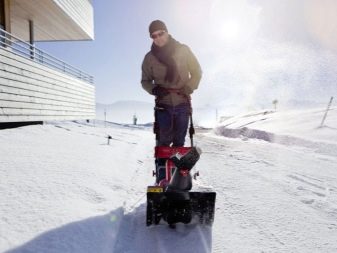

For information on how a gasoline snow blower works, see the next video.



































































The comment was sent successfully.